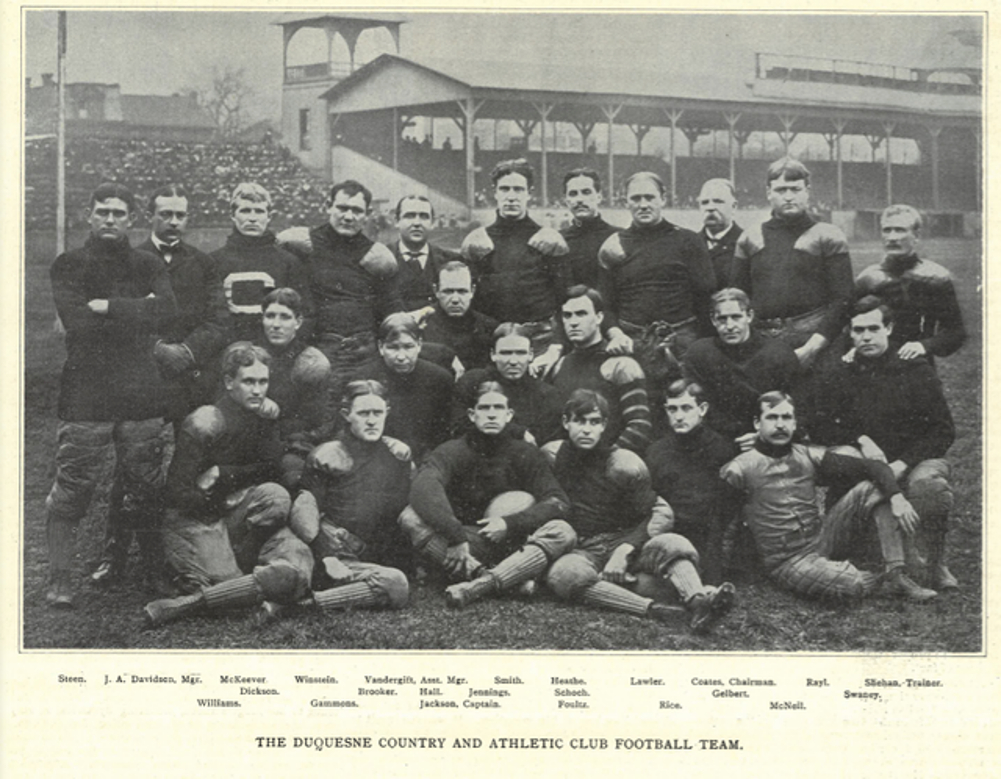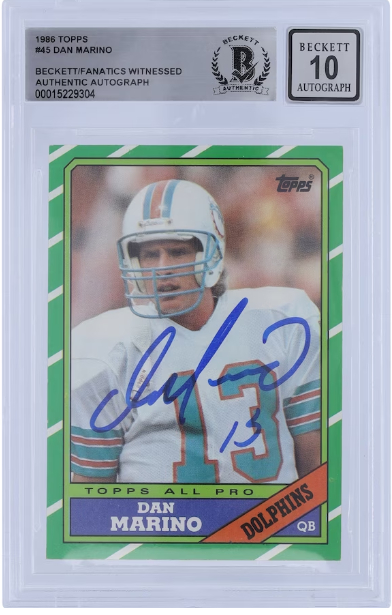In this edition we take a look at the history of one of the best early professional football teams, the Duquesne Country and Athletic Club of the late nineteenth-century.
Duquesne Country and Athletic Club
The origin of the Duquesne Country and Athletic Club
One team that has appeared in our posts on early pro football history over and over again are the 1890s Duquesne Country and Athletic Club teams. The DC&AC first put a football team on the field in 1895. If you remember, this was the same year that the Latrobe Athletic Club paid college student John Brallier to be their quarterback for a few games. This Duquesne club was right there at the beginning as pro football was sprouting, and what a part they partook in the paid level of the games advancement.
The story of the DC&AC starts with the establishment of the club charter sometime in the early 1890s as a social and recreation organization in the Pittsburgh area. These types of clubs were becoming pretty common in that era as the workers in the industrial sectors of America needed to blow off a little steam after work. They had just been recently gaining some freetime from work as labor laws, kept manufacturers from working them unduly long hours each day.
The club at first intended to only use amateur players on the roster when they set out in the 1895 season. After four games, they saw early success and with this gave the team a sense of urgency to hire on some even better players before they played the Pittsburgh Athletic Club, who did have pro players. The practice continued the next year when they sought and contracted even more compensated roster members making them one of the most pro football teams in the land.
1896 season
Only five players returned to the team for the 1896 season. These heavy losses of personnel created line up issues for many of the early games in the 1896 season.
On November 10, 1896 the DC&AC became the first opponents to have ever faced a fully professional football team, Allegheny Athletic Association. The AAA paid a reported average of $100 per game to their roster members. The DC&AC lost this game 12–0 at Exposition Park but is set a motivation in motion to improve. The AAA could not sustain the hefty payroll and immediately ceased operations after shutting out the Pittsburgh Athletic Club a day later.
The season ended on a high note with wins over the Pittsburgh Athletic Club, and Greensburg AC provided the DC&AC a claim as the top of the "big four" Western Pennsylvania athletic clubs, with the LAC included. They were brought to a reality check, though, when the best pure football team in the area, W&J, blanked them on Thanksgiving Day.
A New Team Owner
William Chase Temple, the former Pittsburgh Pirates baseball team minority owner took over the Duquesne Country and Athletic Club, becoming the first individual team owner in professional football in 1897. He saw promise in this team, and felt his knowledge and experience could build something special.
Temple had left the realm of baseball a few years earlier after he felt a bit disrespected by those in baseball. He founded an award called the Temple Cup, a trophy given to the winner of an annual best-of-seven postseason championship series for American professional baseball from 1894 to 1897. Competing teams were from what we call today the National League, but at the time and since its creation in 1876 was known as the National League of Professional Baseball Clubs. The 30-inch tall cup award was donated by Temple and cost him about $800 at the time, equivalent to approximately just over $24,000 in today’s money. Quite a substantial sum, no matter what one's station in life is. In other words, he took the Award very seriously. It didn't go quite to plan for Temple, though. There seemed to be a lack of genuine enthusiasm on the part of the players. Their apathy spread to the fans and made attendance at the Temple Cup games in the latter years be disappointing. Interest in the series faded quickly, as the second-place team had won three of the four series, sort of discrediting the process of the season in the fan's eyes. Thus Temple turned his efforts and money toward the blossoming game of professional football.
The Duquesne Country and Athletic Club was Temple’s first gridiron investment of time and resources in 1897. The DC&AC had become the best professional team in Pennsylvania, equivalent to the best in the world in Temple’s time there. After the 1897 season, the club signed several good players to contracts for the following season. The ending of the Spanish-American War brought an even more significant influx of talent as the soldiers returned home. Temple capitalized on this and built the strongest of all the Pennsylvania teams.
The 1897 DC&AC Football Season
The 1897 eleven started off the season by winning their first seven games, including a 4-0 victory over the Pittsburgh Athletic Club. They may have peaked a tad early as they then dropped 3 of their last four contests to the likes of the Greensburgh Athletic Club, Detriot Athletic Club, and the Washington and Jefferson football teams. It was still a succesful season though as they registered an 8-3 record.
Things to buy here
We have placed some product links on this page. If you purchase by clicking on them, we will get a commission to use to help with operating costs.
1898 Season of the DC&AC
The plans for the 1898 season were even loftier than the season prior. Many more players were contracted to play DC&AC football by Mr. Temple. Things were looking very promising for the team, too, until they were not. The uprise of the Spanish American War took away more than a few of these Temple recruits as soldiers in the War effort.
This adverse situation elevated the skill set of William Chase Temple. He dug deep and found replacement players to fill his roster, and by all reports, some of these second-wave recruitment players may have been more talented than the ones turned soldiers. The Spanish-American conflict ended in August, though, and the originals started funneling home, ready to play some ball too. William C. Temple filled the DC&AC roster with talent, and their payroll was expensive. A sum that was too much for the Club to endure, so Mr. Temple, a man of integrity and honor, bankrolled the team himself, making him the first sole professional team owner.
The starting roster had the cream rise to the top. The ends on the team were Charley Gelbert (former Penn Quaker) and Walter Okeson, who had previously been the head honcho at Latrobe in 1897. Bill Church, a Princeton All-America selection, and Bill Farrar, another former Penn player, covered the tackle positions. Inside were Guards: P J Datz Lawler and Frank Smith from Brown University. Temple poached these two men from the Elizabeth Athletic Club in New Jersey. The center, G A Jennings, used to anchor the Bucknell eleven.
Ed Young returned to the Duquesne backfield in '98 with more fresh signings from the Penn Quakers program and their former team captain Roy Williams and Quarterback C S Williams. Yale's C P Kiefer was the other halfback. As we mentioned earlier, W C Temple filled their bench with players who could have been a formidable roster. Star halfback of Brown University, John Daff Gammons, end Tommy Randolph, tackle Otto Wagonhurst, guard John Wienstein, and back Don McNeil were a few of these studs. The team looked to Roy Jackson for leadership on the field as he acted as both their captain and coach.
This assembled roster looked great on paper, but was even more dominant on the grass. By season's end they had secured a record of 10-0-1 and had only five points scored upon their stingy defense all season. The five points came in the same contest as Penn State scored a touchdown in week 5 as part of a, 18-5 DC&AC victory. Their sole imperfection arrived in the 8th week of the season, when they played the Greensburg Athletic Club to a scoreless tie.
There was no doubts to anyone in the football realm that the Duquesne eleven was the top dog in 1898.
1899 Season

The 1899 Season was very similar to the previous year. There was not a lot of fluctuation in the roster and the team continued dominance on the field finishing with the perfect 10-0 record and again allowing only five points on the season. That lone touchdown was once again scored by the fiesty Penn State team, that got on the scoreboard in the second to the last game of the season at Exposition Park in Allegheny City (Pittsburgh).
This would be the last hurrah for the DC&AC success in football though. The club itself yearned to go into more of an amateur status as the AAU was encouraging collegiate teams to avoid playing pro rosters. WIlliam Chase Temple sensed this turn and as the DC&AC roster was starting to fall apart, Temple defected to lead the Homestead Library and Athletic Club, and took many of his former Duquesne stars with him. Look below to link to our post on the Homestead team we had with an interview with author Gregg Ficery.
Credits
Banner photo is courtesy of Wikimedia Commons of and image of the 1899 DC & AC football team, posed at Exposition Park, Pittsburgh, PA.
Back row, left to right: Joe Steen, J.A. Davidson (manager), Billy McKeever, John Winstein, Joe Vandergrift (asst. manager), Frank Smith, Ralph Heath, Datz Lawler, William Coates (chairman), Doc Rayl, Davy Sheehan (trainer).
Middle, left to right: By Dickson, Norton Brooker, John Hall, George Jennings, L.M. Schoch, Charlie Gelbert, Sweeney.
Front row, left to right: Carl Williams, Daff Gammons, Roy Jackson (captain), Dave Fultz, Herbert Rice, Don McNeil.
The other photo is also from Wikimedia Commons and depicts the US-PA(1891) p723 PITTSBURGH, DUQUESNE CLUB
A Very Special thanks to information obtained from the following brilliant internet sites: Newspapers.com, Wikipedia.com, the Sports Reference's family of website databases & Stathead.com.
PFRA Research. "Last Hurrah in Allegheny: The 3A's Exit in a Blaze of Glory: 1896" (PDF). Professional Football Researchers Association. Retrieved January 7, 2023.
"Scalped by the Redskins". The Pittsburg Post. October 4, 1896. p. 6 – via Newspapers.com.
PFRA Research "Stars Over All-Stars- An All-Star Team: 1898" -Originally Published in From AAA to ‘03 (PFRA Books)
"Good Football". The Pittsburg Press. October 11, 1896. p. 6 – via Newspapers.com.






